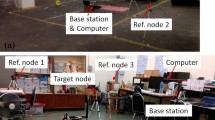Abstract
The performance of three stepwise algorithms designed to improve the accuracy of WLAN-based indoor localisation methods was determined using a robust simulation technique. The majority of WLAN localisation techniques use the receive signal strength indication to estimate a network user’s location using either a deterministic or a probabilistic approach. Previous work has shown that the rms error of these localisation techniques can be over 5 m, which is unacceptably high for indoor applications. Three different stepwise algorithms, two of which are novel, were simulated across several different test bed layouts in order to determine their effectiveness in reducing the error in the position estimate. Of the three algorithms, the constrained movement algorithm offered the best improvement in accuracy with up to a 40% improvement when using deterministic techniques. For probabilistic tracking, there was minimal improvement in the accuracy.
Similar content being viewed by others
References
A. Ward A. Jones A. Hopper (1997) ArticleTitleA new location technique for the active office IEEE Personal Communication 4 42–47
R. J. Fontana and S. J. Gunderson, Ultra-wideband precision asset location system, Proceedings of the IEEE Conference on Ultra Wideband Systems and Technologies, Baltimore, Maryland, May 21–23, pp. 147–150, 2002.
R. Want A. Hopper V. Falcão J. Gibbons (1992) ArticleTitleThe active badge location system ACM Transactions on Information Systems 10 91–102
N. B. Priyantha, A. Chakraborty, and H. Balakrishnan, The cricket location support system, Proceedings of the 6th Annual ACM International Conference Mobile Computing and Networking, Boston, Massachusetts, August 6–11, pp. 32–43, 2000.
P. Castro, P. Chiu, T. Kremenek, and R. Muntz, A probabilistic room location service for wireless networked environments, Proceedings of the Ubicomp, Atlanta, Georgia, September 30-October 2, pp. 18–24, 2001.
M. A. Youssef, A. Agrawala, and A. U. Shankar, WLAN location determination via clustering and probability distributions, Proceedings of the 1st IEEE International Conference on Pervasive Computing and Communications, Dallas, Texas, March 23–26, pp. 143–150, 2003.
A. M. Ladd, K. E. Bekris, G. Marceau, and A. Rudys, Using wireless ethernet for localization, Department of Computer Science, Rice University, Technical Report TR02–393, 2002.
P. Bahl and V. N. Padmanabhan, RADAR: an in-building RF-based user location and tracking system, Proceedings of IEEE Infocom 2000, Tel-Aviv, Israel, March 23–26, pp. 775–784, 2000.
P. Bahl, V. N. Padmanabhan, and A. Balachandran, Enhancements to the RADAR user location and tracking system, Technical Report MSR-TR-2000–12, 2000.
T. Roos P. Myllymaki H. Tirri P. Misikangas J. Sievanen (2002) ArticleTitleA probabilistic approach to WLAN user location estimation International Journal of Wireless Information Networks 9 155–164
J. Hightower G. Borriello (2001) ArticleTitleLocation systems for ubiquitous computing IEEE Computer 34 57–66
G. Durgin T. S. Rappaport H. Xu (1998) ArticleTitleMeasurements and models for radio path loss and penetration loss in and around homes and trees at 5.85 GHz IEEE Transactions and Communications 46 1484–1496
W. H. Press S. A. Teukolsky W. T. Vetterling B. P. Flannery (1992) Numerical Recipes in C Cambridge University Press Cambridge
H. Hashemi (1993) ArticleTitleImpulse response modeling of indoor radio propagation channels IEEE Journals of Selected Areas in Communicaions 11 967–978
S. Y. Seidel T. S. Rappaport (1992) ArticleTitle914 MHz path loss prediction models for indoor wireless communications in multifloored buildings IEEE Transactions of Antennas and Propagation 40 207–217
K. Kaemarungsi and P. Krishnamurthy, Modeling of indoor positioning systems based on location fingerprinting, IEEE Infocom 2004, Hong Kong, March 7–11, 2004.
T. P. Deasy and W. G. Scanlon, Accuracy improvement algorithms for prediction of user location using receive signal strength indication in infrastructure WLANs, to be published in the Proceedings of the 15th IEEE International Symposium Personal, Indoor and Radio Communications, PIMRC, Barcelona, 5–8 September 2004.
Author information
Authors and Affiliations
Corresponding author
Rights and permissions
About this article
Cite this article
Deasy, T.P., Scanlon, W.G. Stepwise Algorithms for Improving the Accuracy of Both Deterministic and Probabilistic Methods in WLAN-based Indoor User Localisation. Int J Wireless Inf Networks 11, 207–216 (2004). https://doi.org/10.1007/s10776-004-1234-1
Issue Date:
DOI: https://doi.org/10.1007/s10776-004-1234-1




